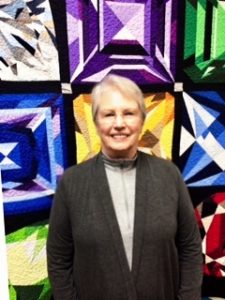
Our 3rd Dinosaur Quilt Pattern: Brontosaurus Using “Slow” Piecing Techniques (English Paper Piecing)
This lovely gal is the 3rd dino in our series. To piece this block using English Paper Piecing techniques (EPP), you’ll print out the 4 quadrants onto C&T Publishing’s English Paper Piecing Specialty Papers, a product created by Becky Goldsmith. CLICK HERE to purchase the individual pattern. You can also purchase all 6 as a set when you CLICK HERE. I’m enjoying this piecing technique, but need lots more practice. Thank goodness we have 6 blocks to help me improve my skill.
The pleasure of EPP is its portability. I traveled to the Berkshires last week for a little vacation and I took my EPP with me. It was fun to have something to work on during the down times. In this post, I’d like to share some of the things I’m learning as I put these blocks together the “slow” way.
If you’re joining me for the first time and are wondering how to get started, I’ve created several short instructional videos demonstrating the following topics:
- Supplies
- Understanding the Pattern
- Cutting Your Fabric Pieces
- Assembling Your Fabric Pieces
You can find these videos by scrolling through past posts from the previous dinosaur patterns. Be sure to select videos that talk about “Slow” piecing. It’s much different than the “Fast” piecing where we use freezer paper. I hope you’re enjoying Annette Frye’s adorable patterns as much as I am! Enjoy the adventure!
Tip #1: Prevent tangles by holding the thread back
Perhaps it’s the thread I’m using, but I find that the 2 strands don’t evenly slide through the fabric and, as a result, knot up.
To mitigate this, I tried holding the thread down against the back of the fabric sandwich as I drew the needle through the top edge of the units.
I kept the thread looped around my fingers as I drew the strands through, keeping the thread relatively taut as the loop got smaller and smaller. This really helped reduce the frustration of knotting and tangled threads.


Tip #2: Trimming uneven edges caused by the added width of multi-piece units.
I was wondering out loud a few weeks ago about how to match the corners of units adjacent to one another. I had a bit of a “Duh!” moment when I realized that attaching a trio of pieces sewn together next to a single piece would NEVER line up perfectly.
That’s because the miniscule (but impactful) depth of the fabric, when multiplied across several pieces, adds width to the overall unit. They will never line up UNLESS you unwrap the edge that is overshooting its adjacent unit and shave off the overhang. I think I might try this solution.



trim it up with scissors, and re-glue the fabric to the template.
Progress Pictures Plus
Enjoy this week’s sewing! I hope you’re staying cool and hydrated wherever you are! It’s sweltering here in Louisville, but a break in the weather is just around the corner.
Be well and shine on!















































